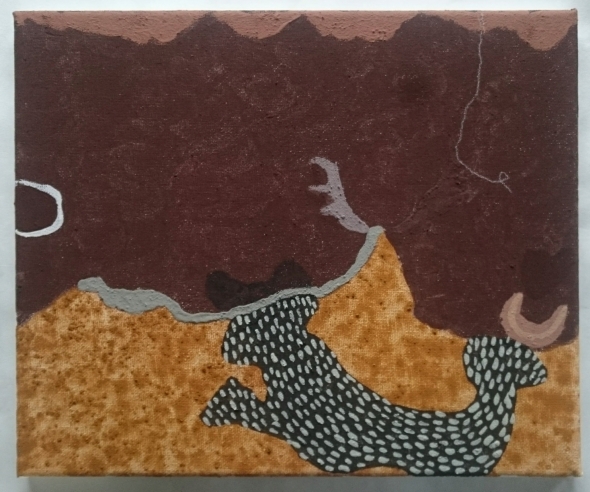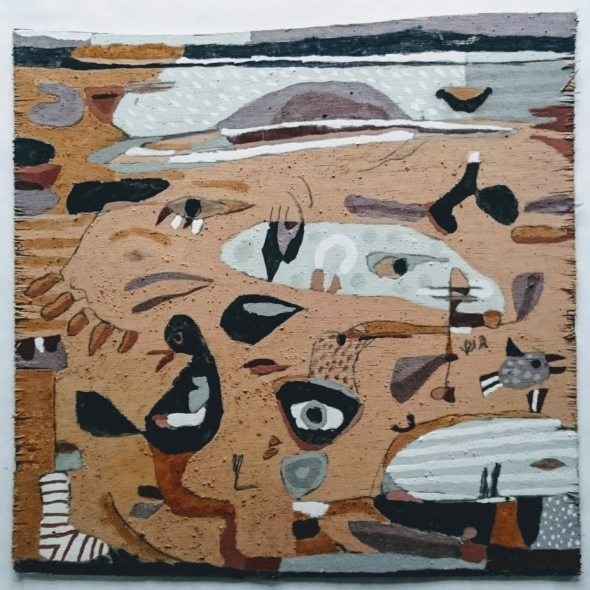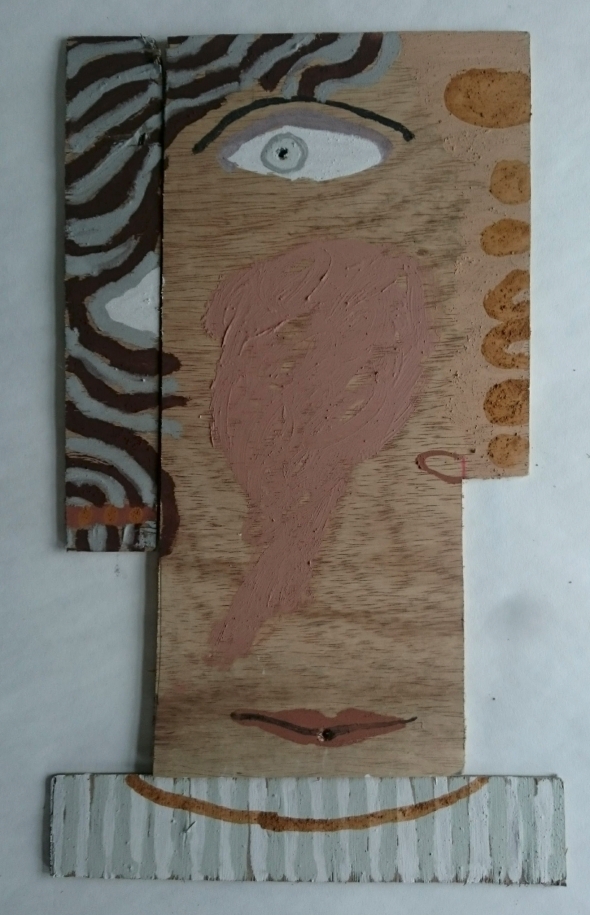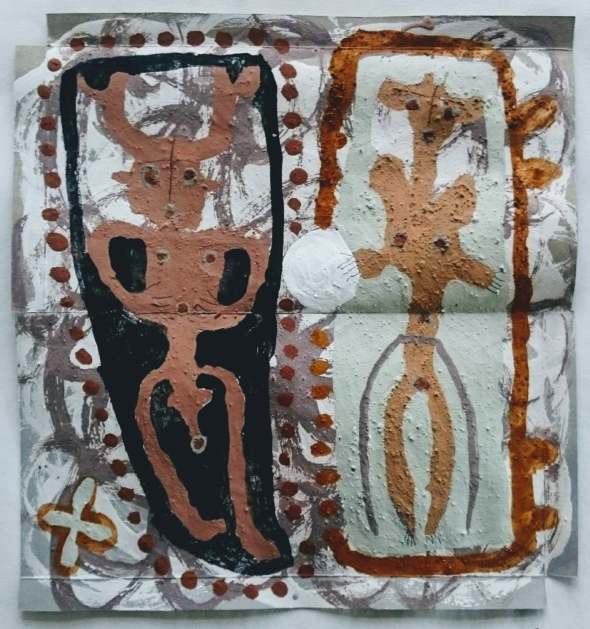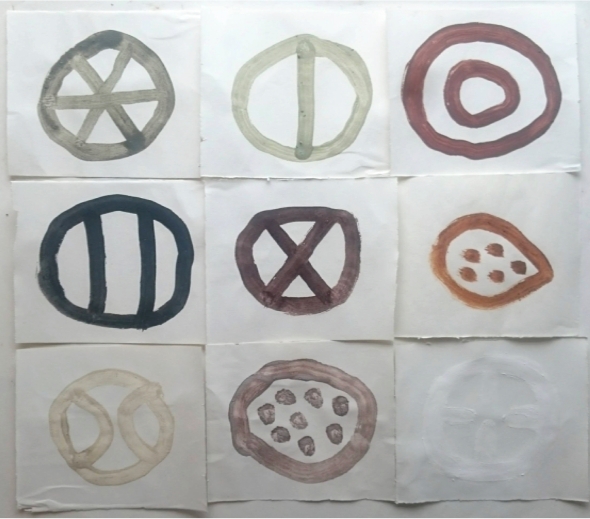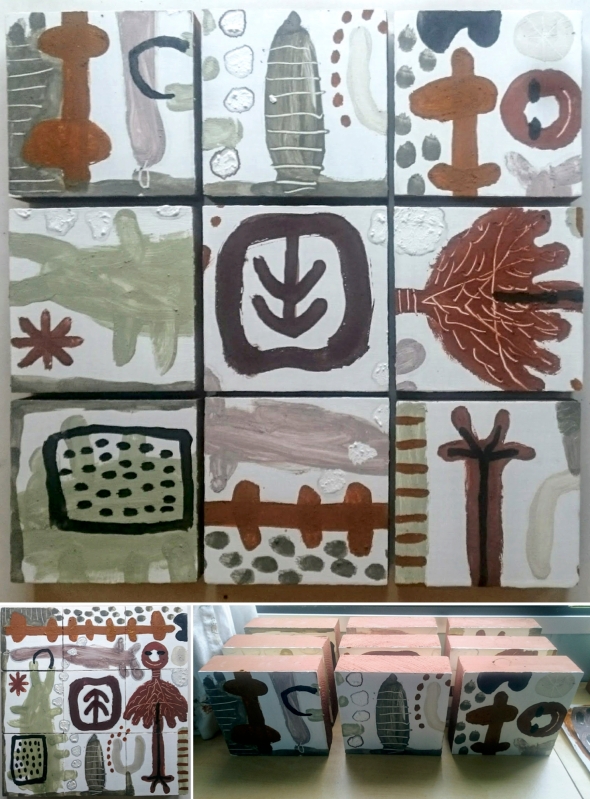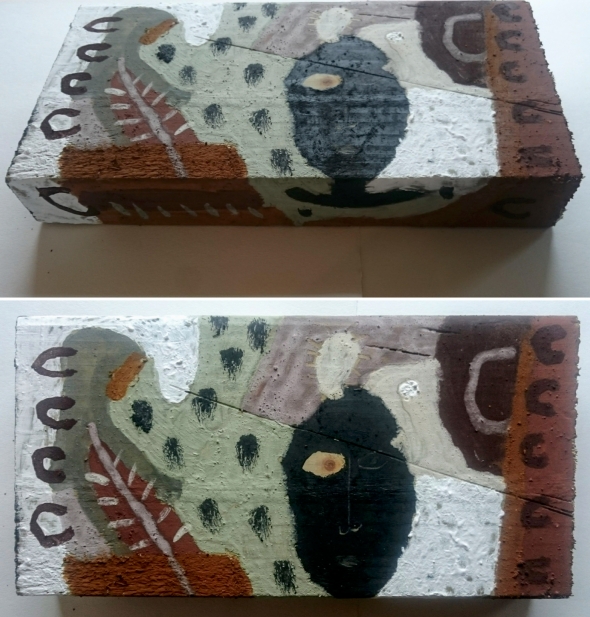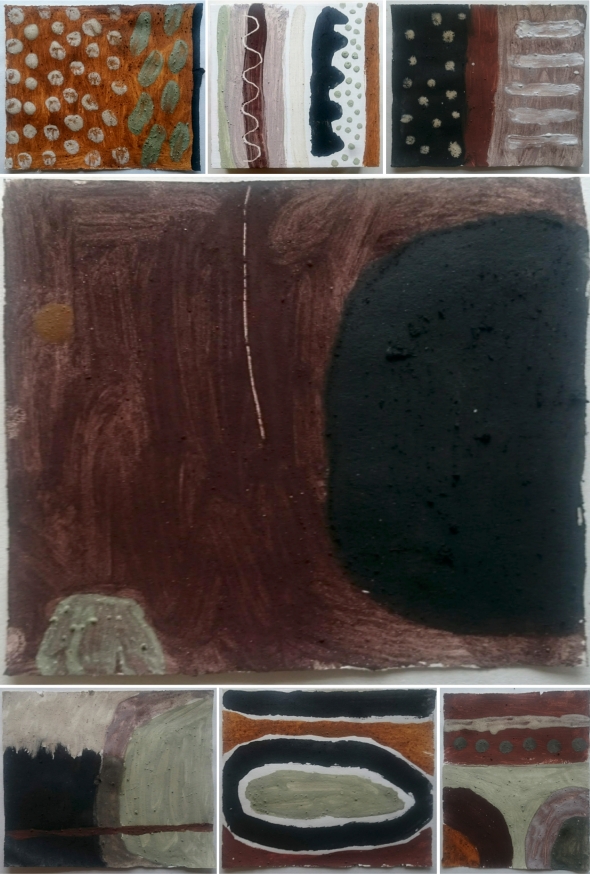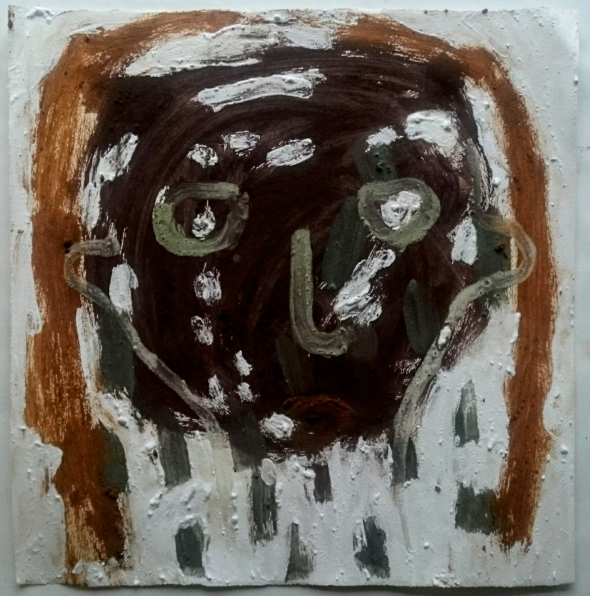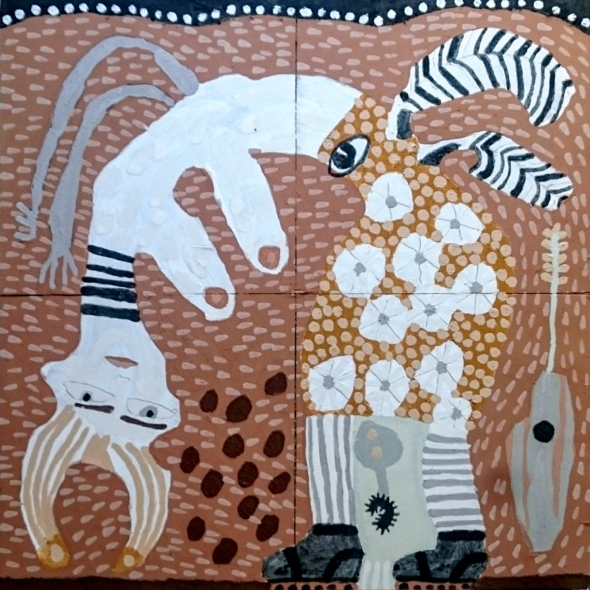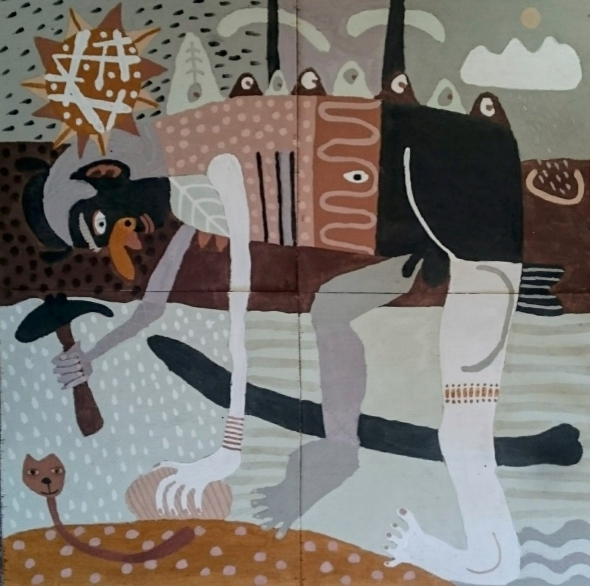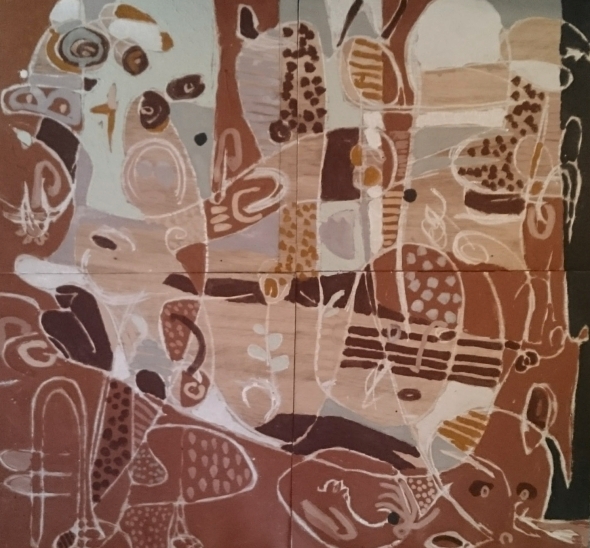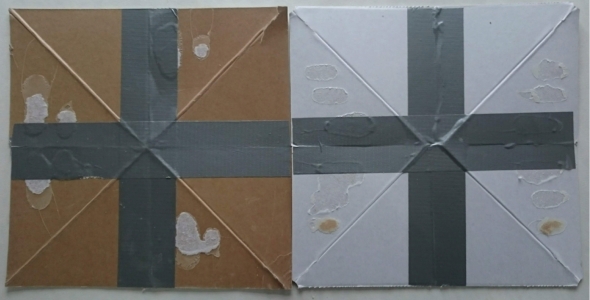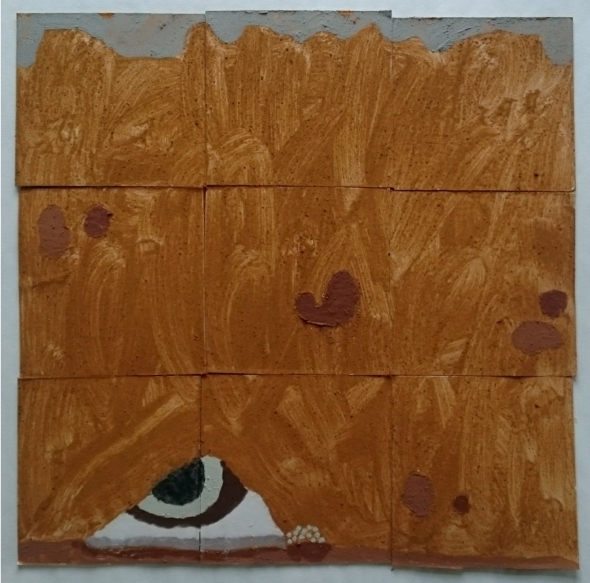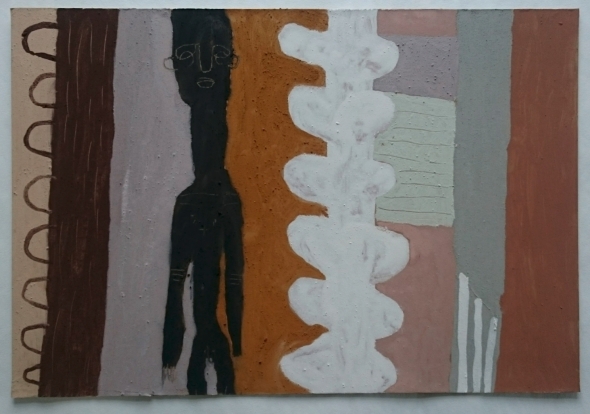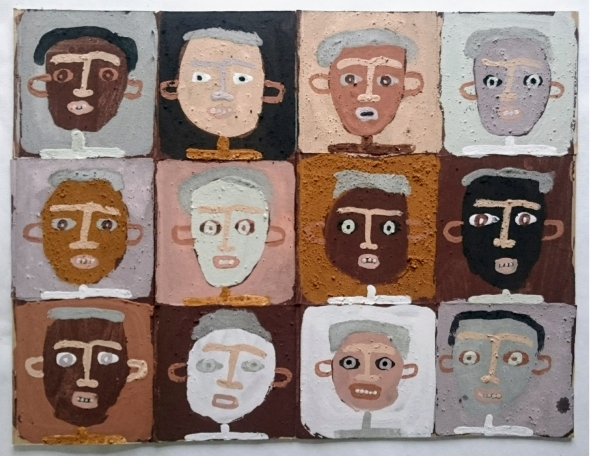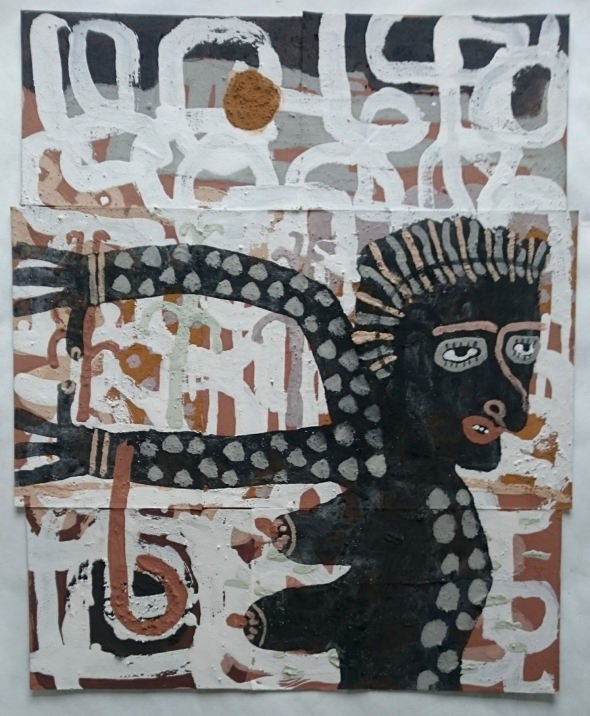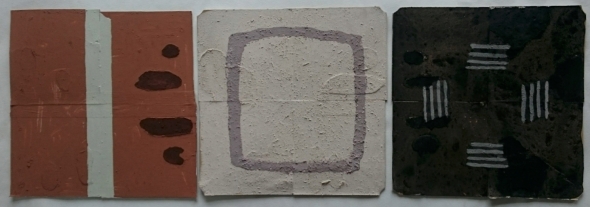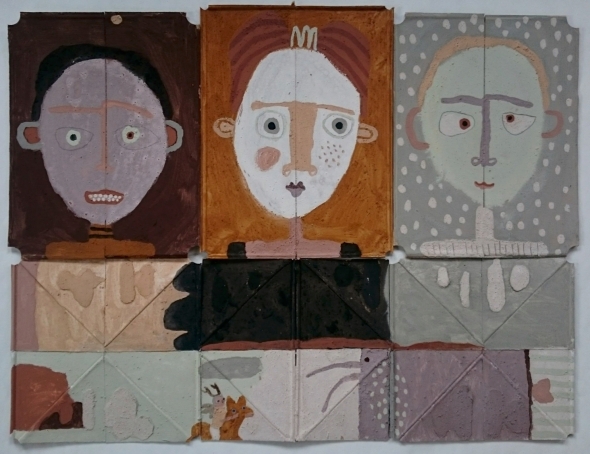no light no colour no more
Posted: February 25, 2019 Filed under: eARTh | Tags: Aesthetics, art and science, Arte Povera, Arts, arts research, Cornwall, earth pigments, eco art, ecopsychology, Environmental art, Feeling, indigenous culture, painting, Pigment, Visual arts 2 Commentsfurther material responses to existential emergence, crisis and change
I was reminded recently, while gazing fleetingly into the shimmering turquoise green blue ocean here in West Cornwall, of my early art training based in the classical understanding of colour. colour as light. a systematic mixing together of homogenous materials to represent the colours that we observe in Nature from a set of ‘primaries’: reds, blues and yellows. no black. white in moderation. of hue.
 iron board, Praa Sands, Cornwall (Cornish earth pigments on rock) © p ward 2019
iron board, Praa Sands, Cornwall (Cornish earth pigments on rock) © p ward 2019
our perception of colour, of light and shade, and hence of depth, size, form and materiality, is sometimes explained as the processing and communication of visual information created by the reflection, refraction and absorption of light in relation to materials. working with earth pigments has revealed ‘colour’ as more than just a visual ‘scientific’ process of perception. it is more a holistic appreciation of material presence which encompasses not just colour but texture, smell and a provenance of time and place, of formation and decay, of ecology, history and Nature itself.
we may often associate earth colours with a range of browns, reds and yellows. with this latest set of paintings I have been enjoying a more subtle selection of greys, greens, mauves and whites that I have found, gathered and mixed near my home.
I could say that the stories they tell are unique expressions of their own experience that I have been privileged to bring into contemporary form, but maybe that is for you to decide…
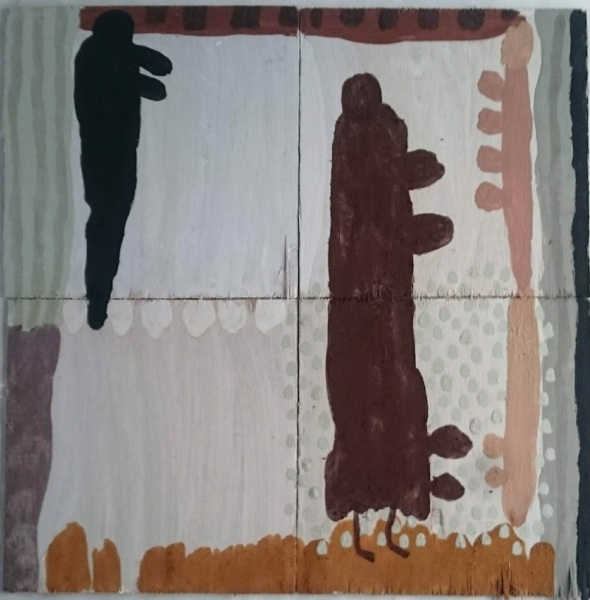 aspects of landscape and love – today it snowed (Cornish earth pigments on board; 51x51cm) © p ward 2019
aspects of landscape and love – today it snowed (Cornish earth pigments on board; 51x51cm) © p ward 2019
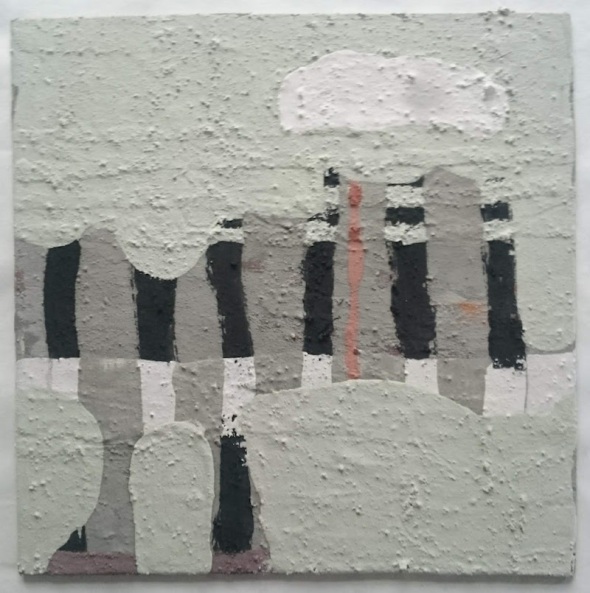 the beautiful things that people say when they are together (Cornish earth pigments on board; 25x25cm) © p ward 2019
the beautiful things that people say when they are together (Cornish earth pigments on board; 25x25cm) © p ward 2019
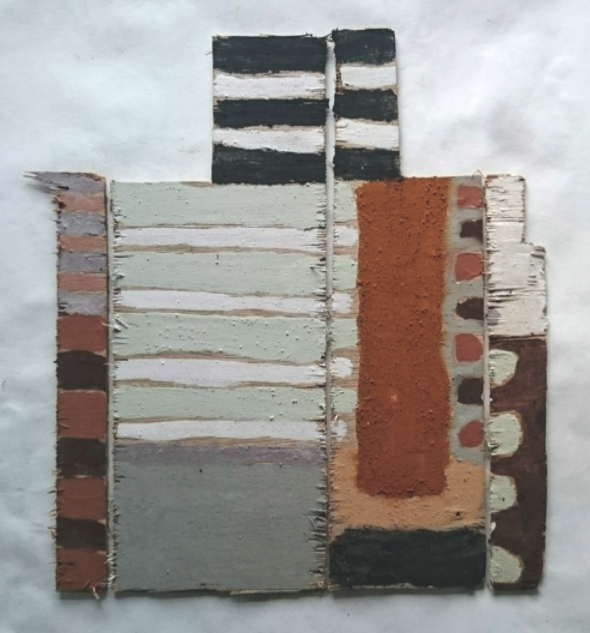 facing up to facing up to (Cornish earth pigments on board; 31x33cm) © p ward 2019
facing up to facing up to (Cornish earth pigments on board; 31x33cm) © p ward 2019
 rearranging the furniture (Cornish earth pigments on board; 35x35cm) © p ward 2019
rearranging the furniture (Cornish earth pigments on board; 35x35cm) © p ward 2019
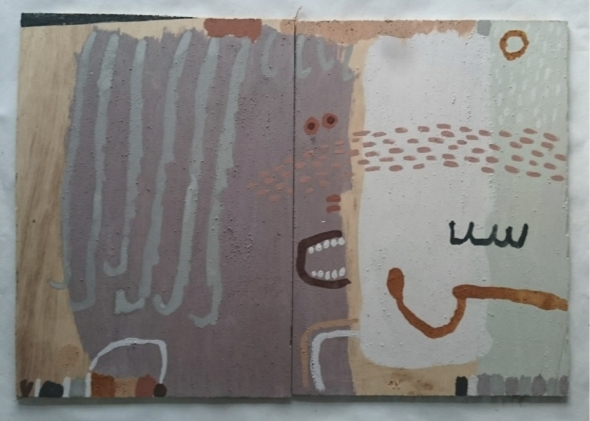 like chopping onions in a northwesterly gale (Cornish earth pigments on board; 56x38cm) © p ward 2019
like chopping onions in a northwesterly gale (Cornish earth pigments on board; 56x38cm) © p ward 2019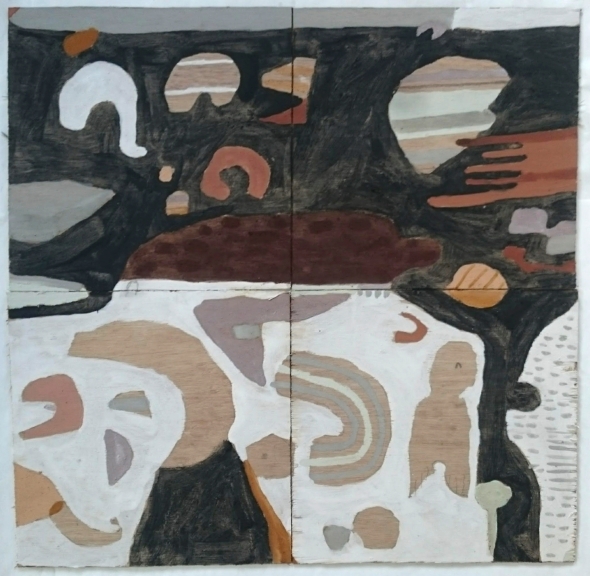 stones that stand in fields with swans and cows and geese: penwith (Cornish earth pigments on board; 70x68cm) © p ward 2019
stones that stand in fields with swans and cows and geese: penwith (Cornish earth pigments on board; 70x68cm) © p ward 2019
 simple communication here (Cornish earth pigments on card; 61x51cm) © p ward 2019
simple communication here (Cornish earth pigments on card; 61x51cm) © p ward 2019
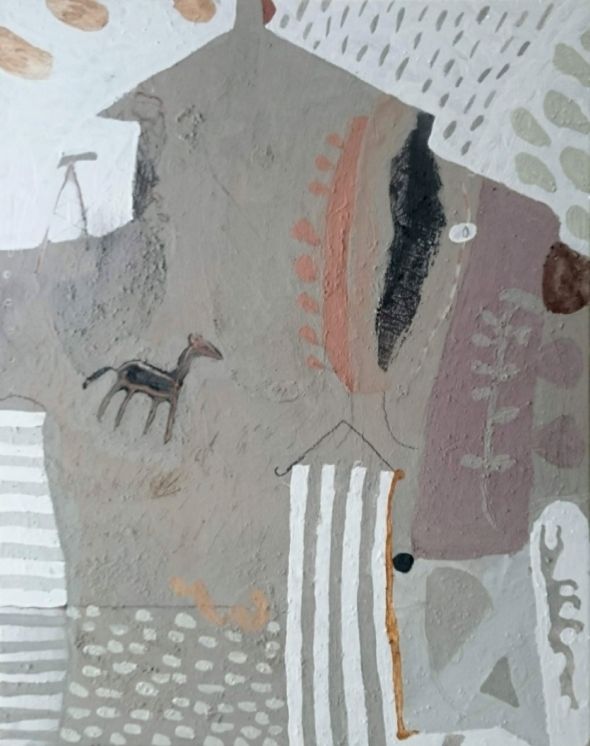 house of power (Cornish earth pigments on canvas; 40x50cm) © p ward 2019
house of power (Cornish earth pigments on canvas; 40x50cm) © p ward 2019
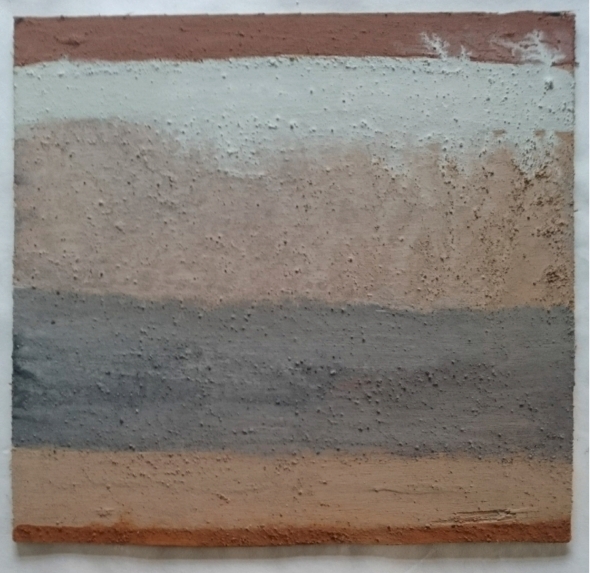 nondescript (Cornish earth pigments on board; 27x26cm) © p ward 2019
nondescript (Cornish earth pigments on board; 27x26cm) © p ward 2019
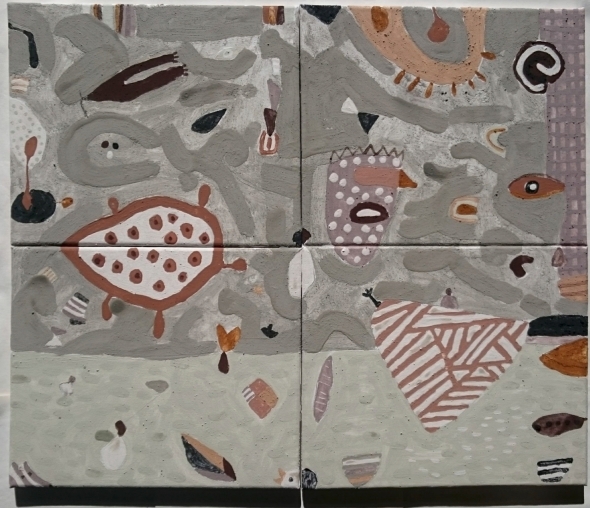 turning a new leaf with foxes on my mind (Cornish earth pigments on canvas; 61x51cm) © p ward 2019
turning a new leaf with foxes on my mind (Cornish earth pigments on canvas; 61x51cm) © p ward 2019
© P Ward 2019
painting within limits
Posted: January 26, 2019 Filed under: eARTh | Tags: Aesthetics, Arte Povera, Arts, arts research, Cornwall, Earth, earth pigments, eco art, ecopsychology, Environmental art, indigenous culture, painting, Pigment, Visual arts 1 Commentnew paintings from Cornwall – early 2019
For many years I have exclusively used colours from the earth in my paintings, gathering and processing all the pigments myself. Each location offers a unique palette and quality of colour to work with as well as a deeper understanding of that place.
To some it may seem as if creativity is being limited. “How can I paint the sky or the trees?” are frequent questions when running workshops. Working with earth pigments has changed the way I work and my understanding of painting in many ways. It has enriched my perception of colour and the ‘material’ of colour. Black is no longer “an absence of light”. For me it allows a specific expression of place orientated, of course, by my own relationship to being there.
The paintings here respond to the nature of earth colours and experiences in West Cornwall…
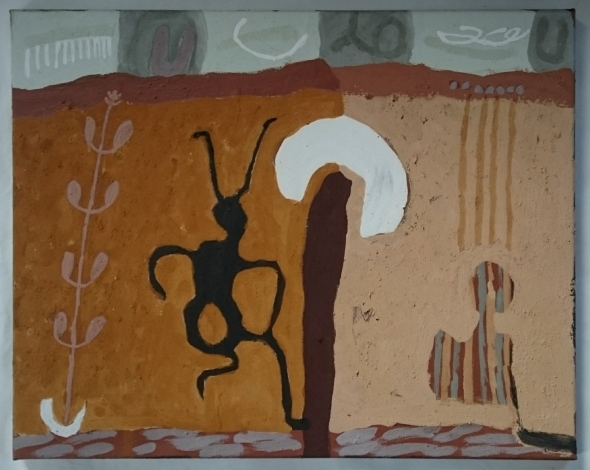 distance what we have become (Cornish earth pigments on canvas; 60x40cm) © p ward 2019
distance what we have become (Cornish earth pigments on canvas; 60x40cm) © p ward 2019
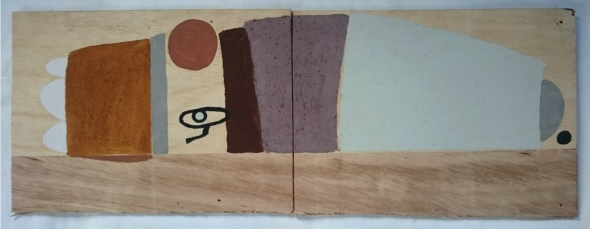 big red wolf moon that I did not see (Cornish earth pigments on board; 76x28cm) © p ward 2019
big red wolf moon that I did not see (Cornish earth pigments on board; 76x28cm) © p ward 2019
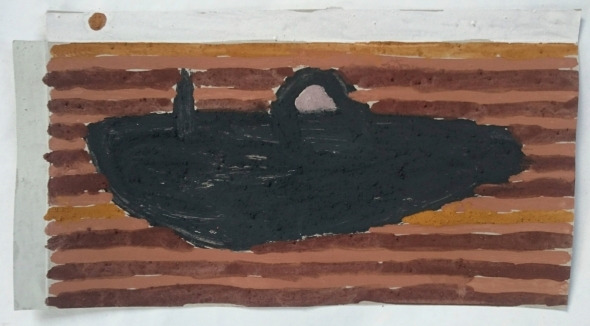 to run aground an island (Cornish earth pigments on card; 27x15cm) © p ward 2019
to run aground an island (Cornish earth pigments on card; 27x15cm) © p ward 2019
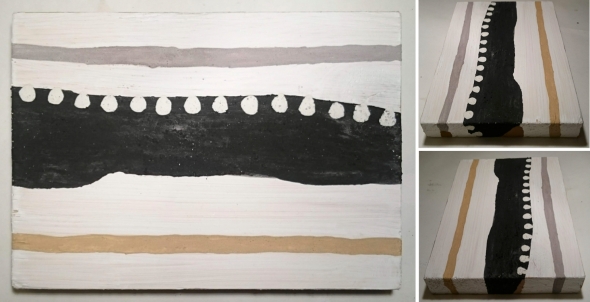 estuary (Cornish earth pigments on wood; 20×14.5x2cm) © p ward 2019
estuary (Cornish earth pigments on wood; 20×14.5x2cm) © p ward 2019
 untitled I, II, III (Cornish earth pigments on board; 25x26cm; 25x28cm; 25x26cm) © p ward 2019
untitled I, II, III (Cornish earth pigments on board; 25x26cm; 25x28cm; 25x26cm) © p ward 2019
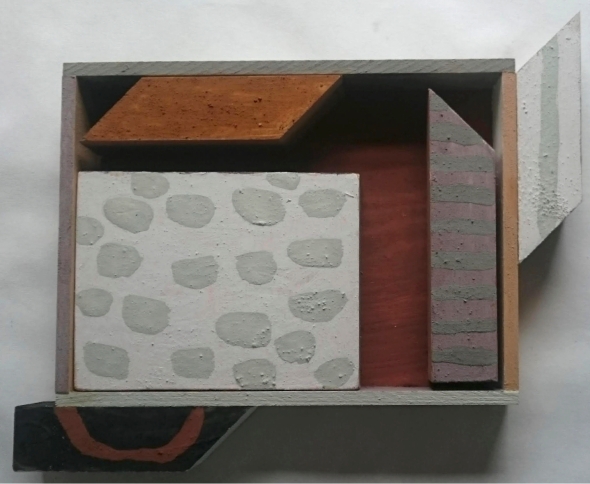 offcuts homestead (Cornish earth pigments on wood; 29x24x3cm) © p ward 2019
offcuts homestead (Cornish earth pigments on wood; 29x24x3cm) © p ward 2019
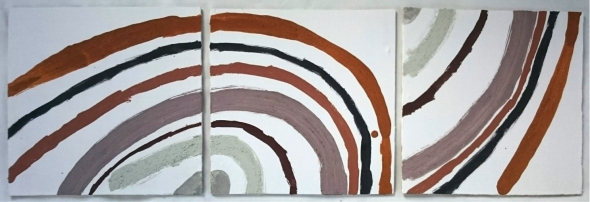 at fault (Cornish earth pigments on board; 80x26cm) © p ward 2019
at fault (Cornish earth pigments on board; 80x26cm) © p ward 2019
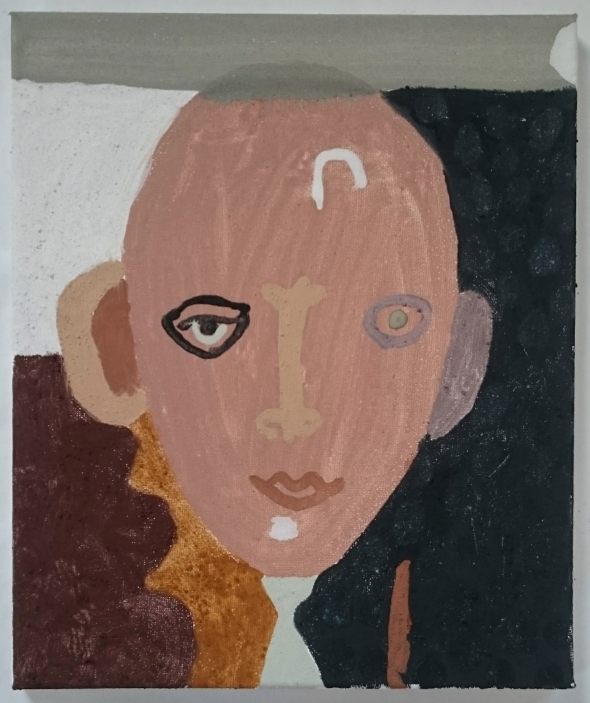 fairy queen (Cornish earth pigments on canvas; 25x30cm) © p ward 2019
fairy queen (Cornish earth pigments on canvas; 25x30cm) © p ward 2019
© P Ward 2019
Painting with Earth – Cornwall: new home, new works
Posted: November 30, 2018 Filed under: eARTh | Tags: Arte Povera, Arts, arts research, Cornwall, earth pigments, eco art, ecopsychology, Environmental art, Feeling, indigenous culture, painting, Pigment, poetry, Visual arts Leave a commentNovember 2018
despite the wind
despite the weather
despite the winter
despite the sense of vulnerability
this raw and new found exposure
despite the twisting and turmoil of our times
despite love
and loss
despite it all
this earth still shines
Before I embark on a new phase of experimentation, combining different binders with the Cornish pigments, I would like to share a few paintings that I have made in my new home – a caravan on a dairy farm in the coastal hills of west Penwith, Cornwall.
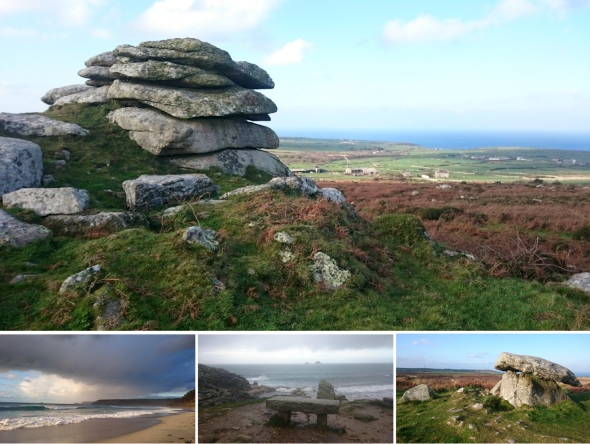 West Penwith, Cornwall – Morvah, Sennen Cove, Cot Valley and Chun Quoit © p ward 2018
West Penwith, Cornwall – Morvah, Sennen Cove, Cot Valley and Chun Quoit © p ward 2018
Here, I am surrounded by the historic land markings of the ancient peoples who populated this extremity of the British Isles. Stone walls, reportedly demarcating some of the oldest working field networks in the world, built 5000 years ago. Iron age hill forts, burial mounds, settlements and wells set in the denuded coastal wasteland of heath and moor. It is at times bleak. After the rain and wind that lashes fresh from the vast Atlantic ocean, the colours of autumn shine. The constantly changing hues of the blue and grey and turquoise sea. Rainbows sitting in our laps. The sky heavy and clear and dark and brooding. Salt water permeating. The animals are exposed by their hunt for food, by the lack of cover afforded by the stripped land. It is a place of spirit and history and life, right now.
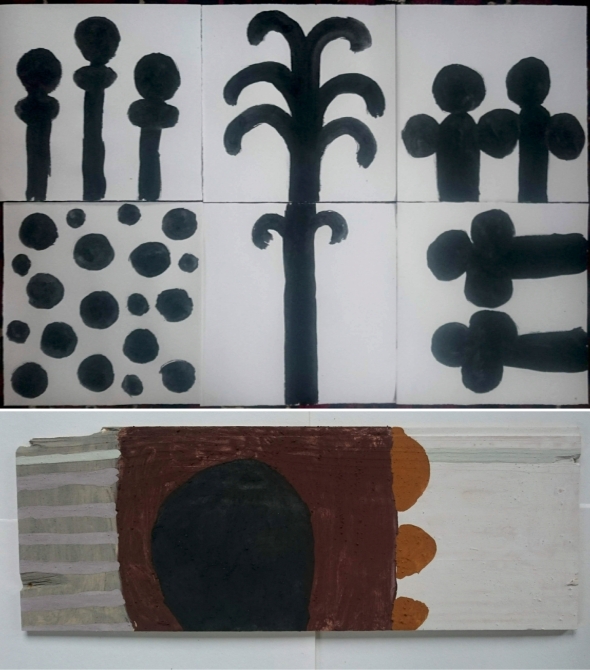 Penwith dream forms (Botallack black on paper); fogou (Cornish earth pigments on wood) © p ward 2018
Penwith dream forms (Botallack black on paper); fogou (Cornish earth pigments on wood) © p ward 2018
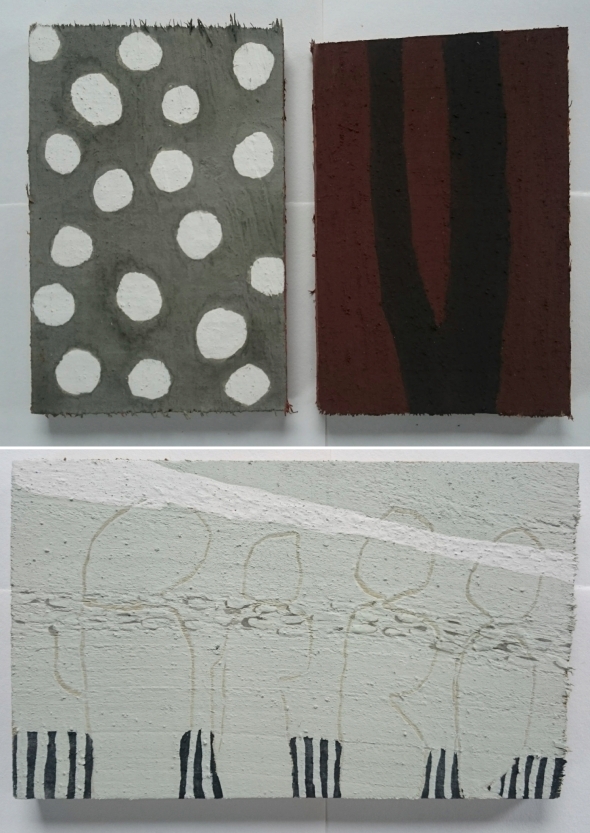 mineral, vegetable; mist (Cornish earth pigments on wood) © p ward 2018
mineral, vegetable; mist (Cornish earth pigments on wood) © p ward 2018
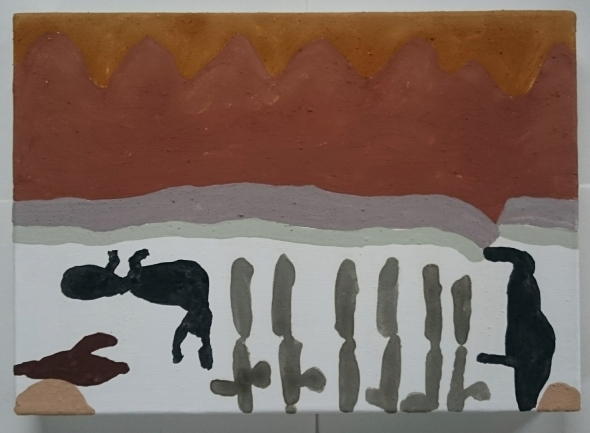 dance on the shore (Cornish earth pigments on canvas) © p ward 2018
dance on the shore (Cornish earth pigments on canvas) © p ward 2018
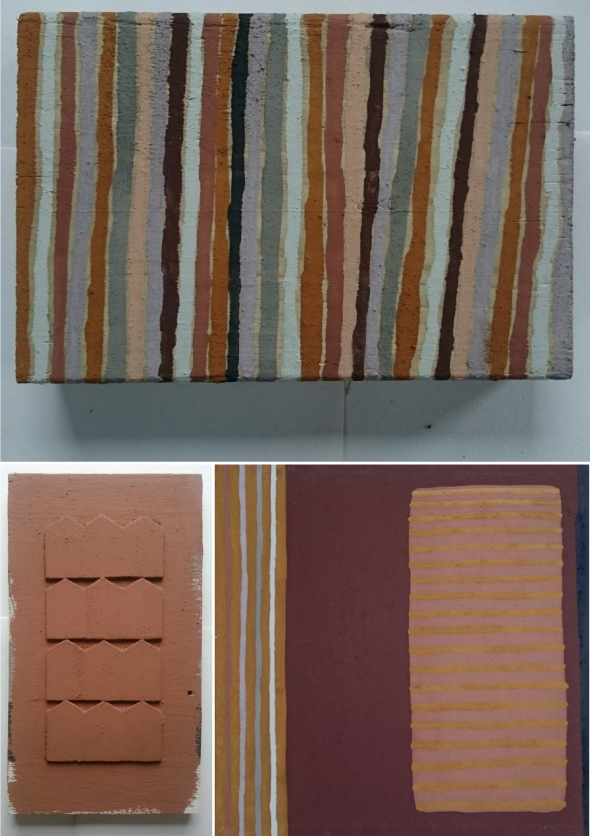 virtually vertical; community (Cornish earth pigments on wood); earth bound (Cornish earth pigments on canvas) © p ward 2018
virtually vertical; community (Cornish earth pigments on wood); earth bound (Cornish earth pigments on canvas) © p ward 2018
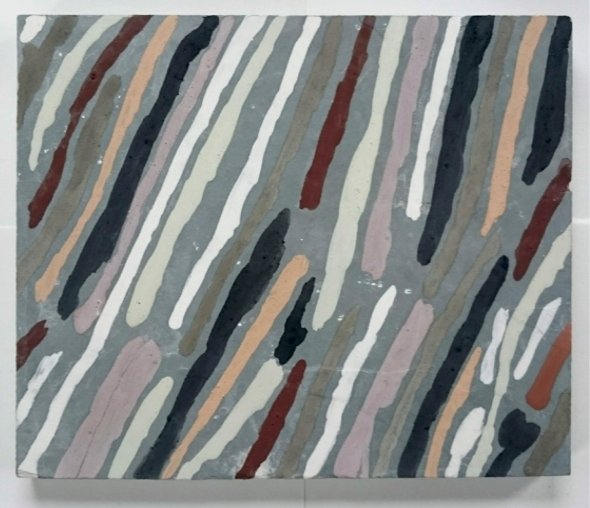 pigment drift (Cornish earth pigments on slate) © p ward 2018
pigment drift (Cornish earth pigments on slate) © p ward 2018
I am slowly learning to listen to the language of the colours here. The earth pigments, their qualities, their sources are unfamiliar. New to me. They are similar in colour to those of North Devon, that I have been using for a long time but very different in other ways. Their formation. Their nature. They have not been part of my own story, until now. The marks and stories they suggest are gradually revealing themselves. Their relationships unfolding. Their dynamic. And despite my attempts at integrity to their provenance and the spirit of this place in which I find myself, it is the freedom of my children’s paintings and drawings that are inspiring me…
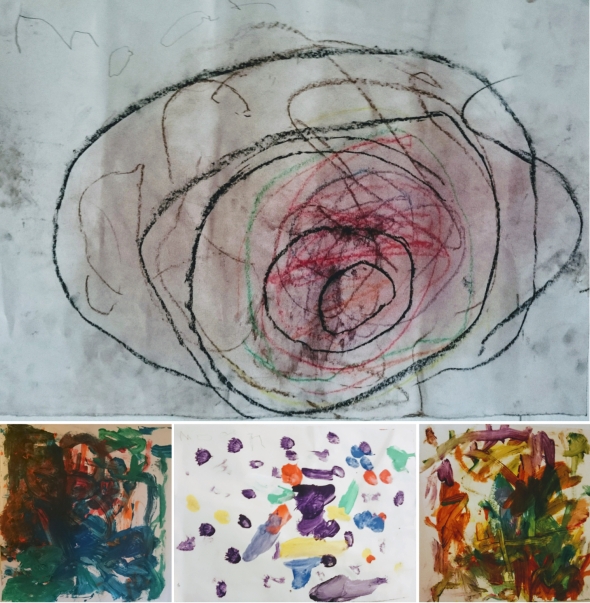 noah, agnes, noah, agnes (pastel and paint on paper) 2018
noah, agnes, noah, agnes (pastel and paint on paper) 2018
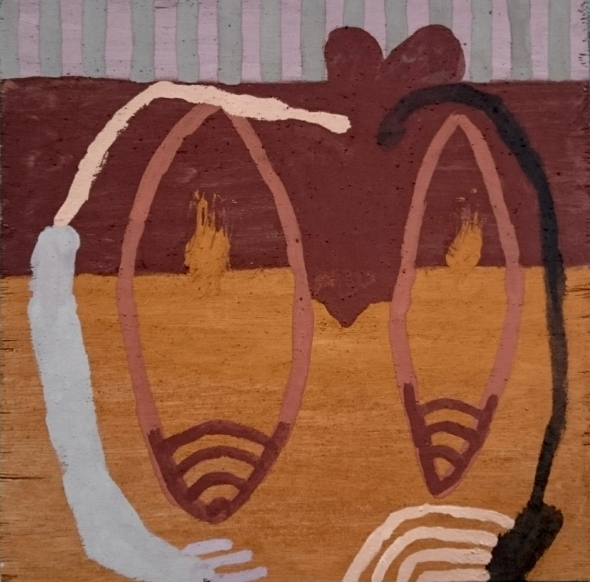 two heads (Cornish earth pigments on wood) © p ward 2018
two heads (Cornish earth pigments on wood) © p ward 2018
 eventual remediation (Cornish earth pigments on wood) © p ward 2018
eventual remediation (Cornish earth pigments on wood) © p ward 2018
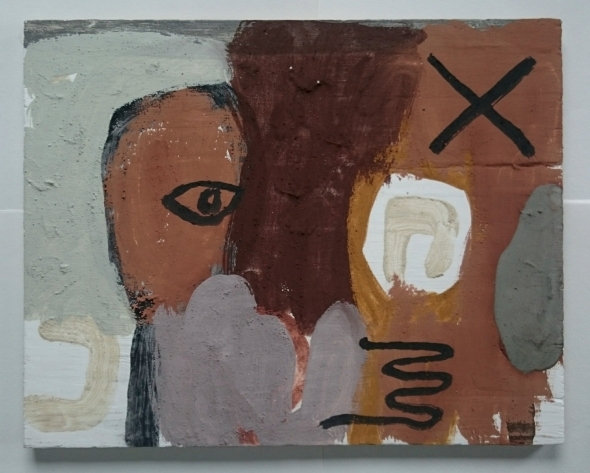 looking for love (Cornish earth pigments on wood) © p ward 2018
looking for love (Cornish earth pigments on wood) © p ward 2018
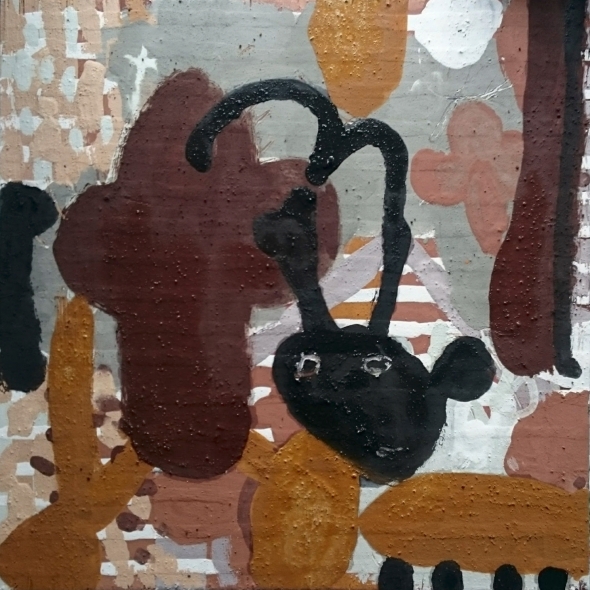 Cornish Folk Tale I (Cornish earth pigments on wood) © p ward 2018
Cornish Folk Tale I (Cornish earth pigments on wood) © p ward 2018
Professionally, I am working on an Arts Council National Lottery Project Fund proposal in association with Geevor Tin Mine to research the creative and educational potential of the pigments. Through recent projects and contact with the staff at the Mine I have started to appreciate and become really excited by the rich historical, geological, chemical and social provenance that the colours carry. After the far-reaching and ongoing success that Painting with Earth – North Devon has brought, let’s hope I will get some real financial support to enable the continuation of this rich seam of work ;-).
© P Ward 2018
painting a parish future – Pendeen in St Just, Cornwall
Posted: November 29, 2018 Filed under: activ8, eARTh, educ8 | Tags: arts research, Cornwall, earth pigments, eco art, Ecology, ecopsychology, Environmental art, indigenous culture, Interdisciplinarity, Mining, painting, Painting Together, Pigment, Visual arts 2 CommentsESRC Festival of Social Science, 10th November 2018
background
I met Dr Joanie Willett at a ‘Melting Pot’ event at Exeter University’s Environmental Sustainability Institute at Penryn Campus in Falmouth, Cornwall. The purpose of the event was to provide opportunities for cross-disciplinary collaborations. Dr Willett was fascinated by aspects of the geology behind earth pigments, particularly of those connected with mining waste, and of the potential for public engagement that my workshops provided. I was intrigued by Dr Willett’s studies around Parish Councils and how to promote public engagement in the political process, reminding me of conversations I had in Australia around the ecological basis of Aboriginal tribal councils.
After a further meeting, held as a walk along the ‘Tin Coast’ in West Penwith between Pendeen and Botallack, we decided to organize a public workshop exploring these principles. Funding was obtained from the Economic and Social Research Council and Exeter University as part of the Festival of Social Science, a national event making Social research accessible to the general public.
where the personal becomes POLITICAL: the idea
Our personal experiences, knowledge and perceptions of the places we live are all valid contributory factors to the cultural truth of a place. In Western democracies the starting point for policy decisions are ideally based in such cultural truths. Parish councils, of which there are some 10,000 in the UK, are the gathering places for the diverse cultural perception of our local communities. Beyond this such cultural perceptions are strongly influenced, if not determined, by the geographical identity, the physical ecology and resources, of a place.
painting a parish future offers a creative space to cultivate and share personal experience, knowledge and future visions of the places that we live.
It is hoped that the creation of such a space within a working Parish may encourage a spirit of commonality and cooperation within groups that may too easily become competitive and detached from the truth of a regions imminent ecology, in respect of all its inhabitants.
painting a parish futureis a collaborative research project led by politics lecturer Dr Joanie Willett and ecological artist Peter Ward in association with Exeter University’s Environmental Sustainability Institute. The project will utilize a shared knowledge of local political process and creative environmental engagement.
An initial enquiry will gather local people, parish councilors and experts to walk and share experiences and knowledge in a reflective process in the Parish of St Just in west Cornwall. The daylong event will culminate in a communal painting using gathered materials to express a shared vision of the future. The painting and further documentation of the event will be exhibited at the ESI at Penryn Campus and at a local venue in St Just Parish.
painting a parish futurewill run alongside ongoing national and local initiatives ‘Going Wild’ with Cornwall Council and the Cornwall Wildlife Trust and the St Just and Pendeen Neighbourhood Development Plan.
The project will provide a model for further actions in local communities across the UK, international research with Indigenous communities in Australia and the basis for an academic paper in relation to such activities, as well as a real focus for community action in the place it is performed.
in practice
The event was advertised locally in the Parish ‘Outreach’ magazine, through flyers in local shops and on notice boards and through personal invitation to relevant experts. It was hoped that we would have a group of about 20 people for the event. In practice, we were fortunate that a County Councilor expressed her interest from an early stage, inviting a simple presentation at a Town Council meeting in St Just to further promote the event. On the day, 2 people who had signed up did not show leaving us with a group of 7, including Dr Willett and myself. While the response was a little disappointing, and indeed raised a very important discussion regarding public engagement, the small number did allow for more focused time and intimate space for discussion and sharing and better engagement with the process.
Part of my personal motivation for the event was to begin to learn more about the place that I live. Both my own background research about the area and the process of organizing the event provided interesting insights into the present social dynamic and historical roots of the parish. Another part was to establish contacts within the community and with relevant organizations for future projects.
 Poster/invitation for painting a parish future – Pendeen in St Just; 7 Cornish pigments, earth colours used in communal painting © p ward 2018
Poster/invitation for painting a parish future – Pendeen in St Just; 7 Cornish pigments, earth colours used in communal painting © p ward 2018
Participants included an artist, a politics lecturer, an environmental educator and project manager, a childminder, County Councilor, Town Councilor and a geologist, providing the basis for lively, diverse and informed discussion throughout the day with many thoughts for positive action being shared.
The morning walk took us through the village of Pendeen to the recently restored leat (a community project initiated by a member of the group), through the historic mining community of Lower Boscaswell, to the medieval ‘holy’ well and then through remains of Geevor Tin Mine and ancient field networks down to the coast, before heading back to the Parish Hall for lunch. Conversation within the group flowed easily between the whole group and individuals and covered topics from local planning policy, local history and geology, the influence of the environment on agriculture, national environmental and political attitudes, interspersed with a shared appreciation of the natural world, and in particular the local environment. Lunch was a homemade vegetable soup, made using exclusively local produce from the community farm, along with local cheese and bread and a splendid array of cake.
Pendeen Parish Hall, photo courtesy J Willett
The process of painting (interesting for my part for the lack of ‘artists’ in the group) took participants a little out of their comfort zones but allowed us to ground our thoughts in a meaningful and enjoyable way. The pigments themselves offered further insights into the local environment, as well as paint making. The painting itself was structured through an approximation of the evolutionary process, starting with imagery around geology, then land use and flora and fauna and lastly human intervention. Despite the initial discomfort, participants recognized the value of the process, at whatever level individuals felt able to contribute, and enjoyed the end result.
painting a parish future – Pendeen in St Just, photos courtesy J Willett and M Ward
conclusion and further action
Despite the somewhat disappointing public response to the event, it was agreed that it had been a useful and inspiring day with everyone feeling they would use what they had learnt in some way. Some said they ‘had never participated in anything like it before’ and that it had revealed a new way of working in the public sphere. I was personally encouraged by how everyone got involved with the process and in particular how the act of painting with local pigments was enjoyed and valued.
As a facilitator, whenever I approach an event such as this I will necessarily fill my mind with any relevant information I wish to share and a structure I aim to run the day through. In practice, especially when working with adults, it is essential that such plans are held merely as guidelines and that the process and dynamic of the group are allowed to express themselves for a satisfactory outcome to be achieved. Indeed, it is inherent to the process that the day is allowed to progress organically within any practical limitations, such as time, space, numbers and sustenance, to be true to itself. What is exciting about such a process is exactly those surprises or unknowns that arise, leading us to new ideas and future actions.
Through contacts made at the Town Council presentation, it is hoped that the painting and research will be exhibited at St Just Library, while also being shared with the Town Council and Local Neighbourhood Development Plan as an example of public engagement. Discussion has already begun regarding further collaboration with Dr Willett with the possibility of developing the event in other areas. Business and public groups in the area have also approached me to run similar workshops for upcoming events.
painting a parish future– Pendeen in St Just, communal painting, earth pigments on board © p ward 2018
Thank you to everyone who participated in the event, for the support and interest of the local community and especially to Joanie for her contributions and collaborative insights.
© P Ward 2018
a journey of wonder down under…
Posted: August 26, 2018 Filed under: A BUNDLE OF STICKS, activ8, eARTh | Tags: arts research, Australia, collaboration, earth pigments, Ecology, ecopsychology, Environmental art, indigenous culture 1 Commentfebruary – march 2018
In February I was most fortunate to enjoy a holidayin southeastern Australia, although like all ‘holidays’ for artists it became an excellent and inescapable opportunity for some research. I travelled with my partner and two young children, adding a beautiful dimension to an already very special journey.
 Royal Botanic Gardens, Sydney, NSW © p ward 2018
Royal Botanic Gardens, Sydney, NSW © p ward 2018
 White Ibis and rock face, Sydney, NSW © p ward 2018
White Ibis and rock face, Sydney, NSW © p ward 2018
From childhood I have had a fascination with Aboriginal culture and part of our visit was to meet up with friend and elder Noel Butler of the Budawang people from the Yuin Nation (http://nuragunyu.com.au). Noel generously welcomed us to his land and shared some memorable, and not always comfortable, insights into native and contemporary culture that strongly influenced my sense of Australia during my visit. Spending time with Noel, in his own land, also inspired much creative ecological experience and thought that I aim to explore more deeply over the coming years.
 Home for a while, Nura Gunya, NSW © p ward 2018
Home for a while, Nura Gunya, NSW © p ward 2018
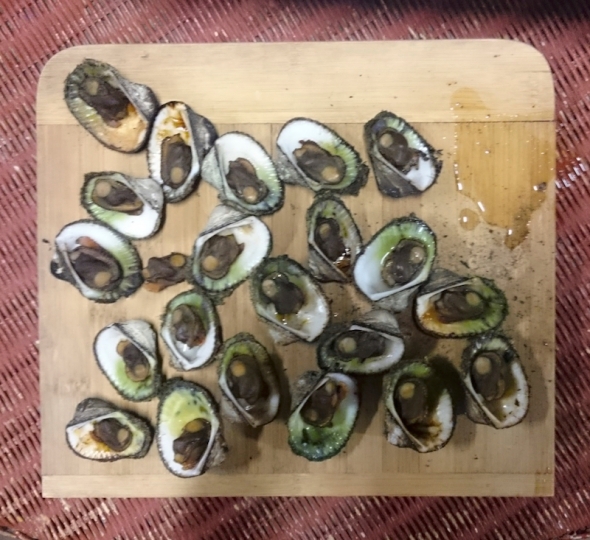 Barbecued clams from Burrill Lake, Ulladulla,NSW © p ward 2018
Barbecued clams from Burrill Lake, Ulladulla,NSW © p ward 2018
Being the furthest I have ever travelled I was not sure what to expect. I am quite new to international travel, spending my life so far enjoying and celebrating the wealth of experience and life present closer to home. I carried with me a glut of preconceptions of Australia that didn’t take too long to be completely pulled apart. Having spent a few days exploring (and recovering from Jetlag) in Sydney – on first impressions a fascinating, vibrant and multicultural city – we set off in a small, and somewhat temperamental, hired camper van.
Even before leaving the city the wealth and diversity of unfamiliar flora and fauna had sent my senses reeling. What struck me first was that I did not see one species of bird that I may have seen in Europe and as we travelled this became more and more apparent. Added to the wonderful heat and climate the flora cloaking the immense Pacific coast landscape brought me to realise how different this place was. The sun was in the North!? The wind was coming from the ‘wrong’ direction. The weather patterns were beyond my comprehension…
 Bush (Murrumbidgee River, Canberra), ACT © p ward 2018
Bush (Murrumbidgee River, Canberra), ACT © p ward 2018
 Playing in the water (Murrumbidgee River, Black Mountain Peninsula), ACT © p ward 2018
Playing in the water (Murrumbidgee River, Black Mountain Peninsula), ACT © p ward 2018
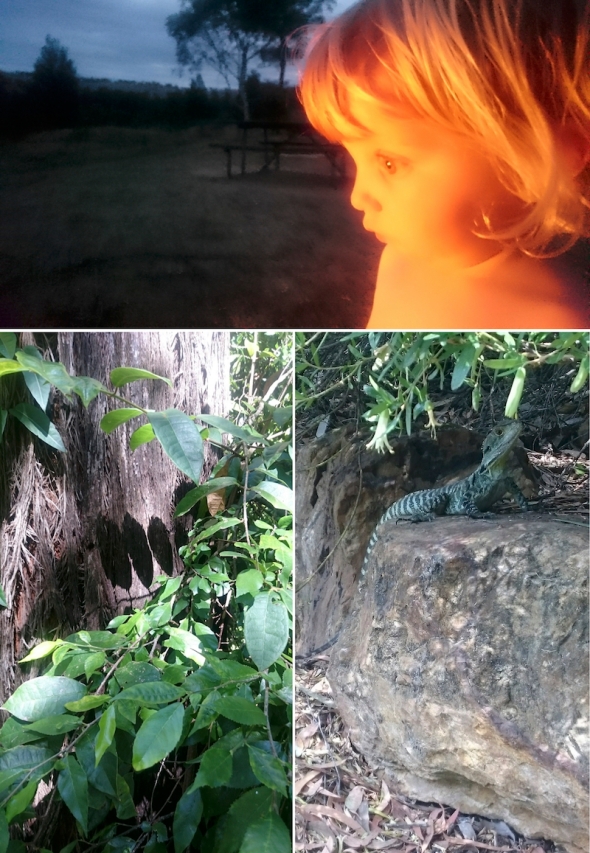 Fire, Flora and Fauna (Murrumbidgee River, Australian National Botanic Gardens), ACT © p ward 2018
Fire, Flora and Fauna (Murrumbidgee River, Australian National Botanic Gardens), ACT © p ward 2018
 Roadside, Namadji National Park, NSW © p ward 2018
Roadside, Namadji National Park, NSW © p ward 2018
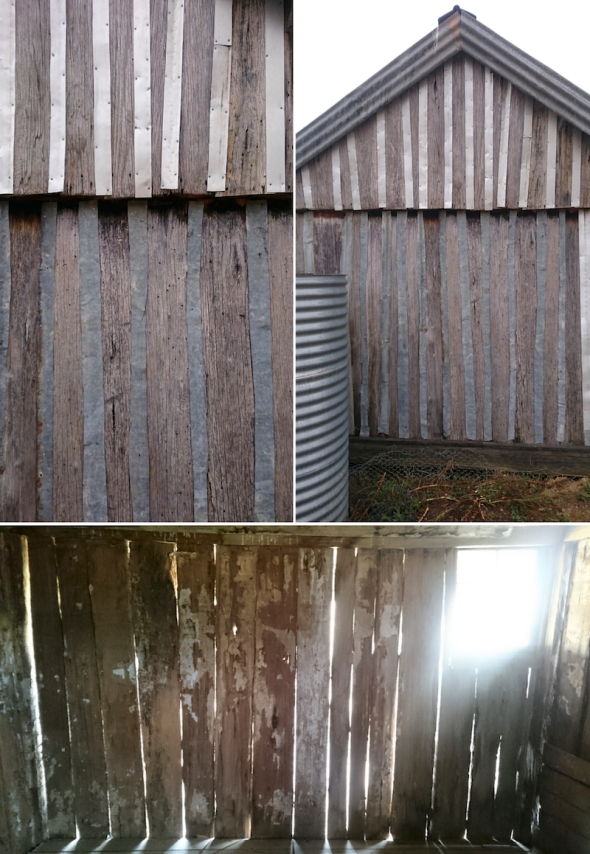 Brayshaws Homestead, Namadji National Park, ACT © p ward 2018
Brayshaws Homestead, Namadji National Park, ACT © p ward 2018
 Kangaroos, Namadji National Park, NSW © p ward 2018
Kangaroos, Namadji National Park, NSW © p ward 2018
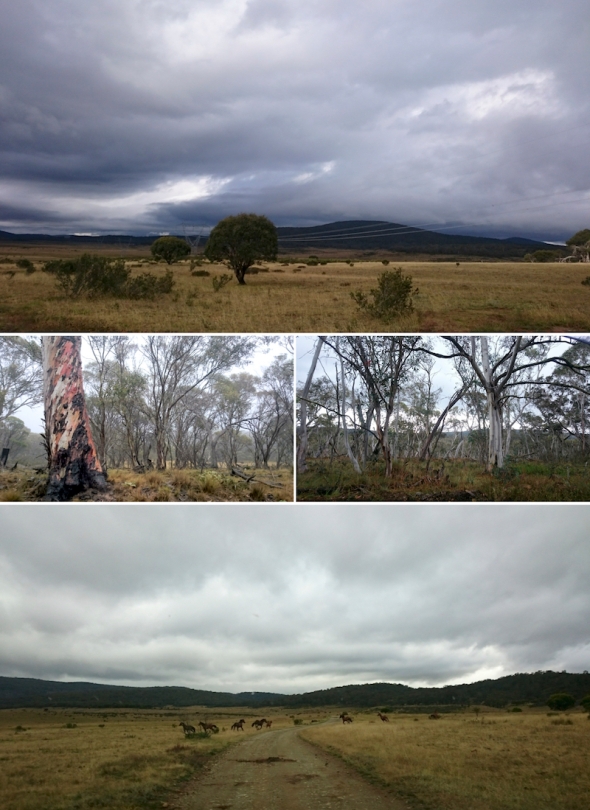 Long Plain, Namadji National Park, NSW © p ward 2018
Long Plain, Namadji National Park, NSW © p ward 2018
From Sydney we headed south along the Pacific coast as far as Bateman’s Bay before heading inland to Australia’s new and strange administrative capital, Canberra. From there we drove further south and up into the Kosiosko Mountain range where temperatures dropped to as low as 6C (in contrast to a pleasant 32C in the city). Staying with friends and family and then becoming familiar with the ‘free’ camping grounds in the country’s National Parks our travel was relatively inexpensive. It was so refreshing to be in a place that actively encouraged outdoor experience, with excellent facilities such as gas barbecues and compost toilets provided in the most remote places, although the road surfaces often shook us to our very cores.
 Cooleman Homestead, Namadji National Park, NSW© p ward 2018
Cooleman Homestead, Namadji National Park, NSW© p ward 2018
 Blue Waterholes Campground , Namadji National Park, NSW © p ward 2018
Blue Waterholes Campground , Namadji National Park, NSW © p ward 2018
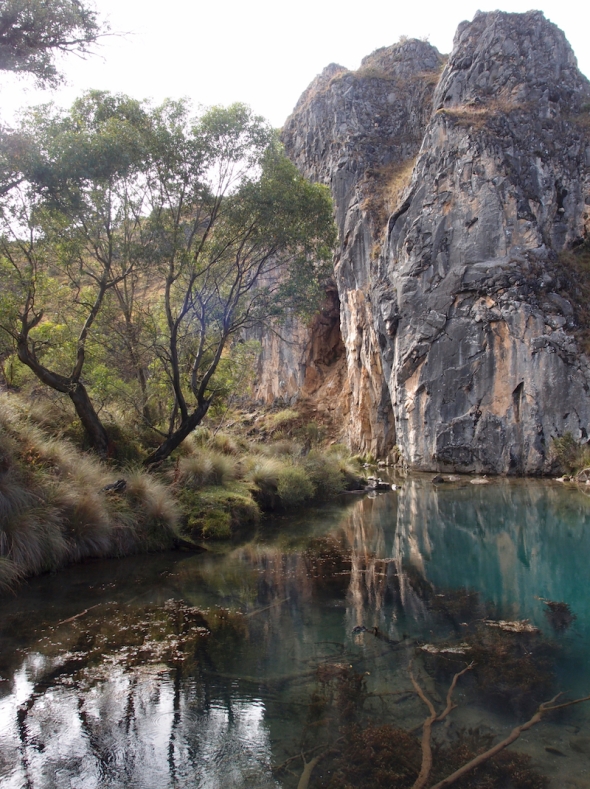 Blue Waterhole, Namadji National Park, NSW © p ward 2018
Blue Waterhole, Namadji National Park, NSW © p ward 2018
To fully articulate or describe the depth and insights of the whole experience would need a book, with a great many pictures, even more than I have shared here, so I will spare you that for now. However, I know that over the coming years such experience will become evident in my work both in terms of further travel, sensitivity to my own cultural and ecological identity, and participation in Australian culture and the understanding communicated through it. I have already been invited back to explore local pigments and art with Noel and hope to take up that offer as soon as I am able.
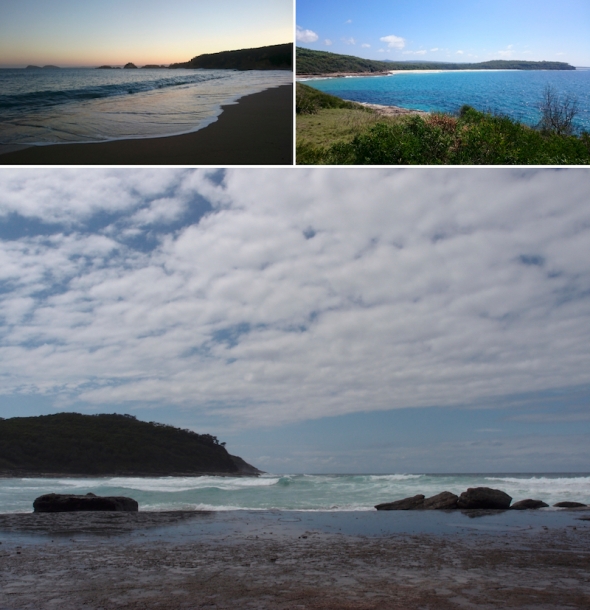 Coast (Pebbly Beach, Nuggan Point, Pretty Beach), Shoalhaven, NSW © p ward 2018
Coast (Pebbly Beach, Nuggan Point, Pretty Beach), Shoalhaven, NSW © p ward 2018
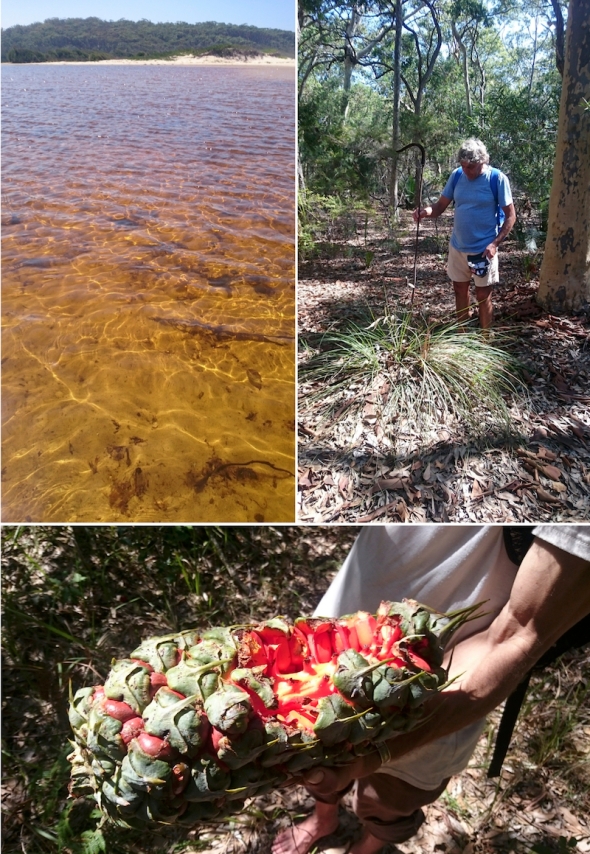 Bush Walk, Nuggan Point, NSW © p ward 2018
Bush Walk, Nuggan Point, NSW © p ward 2018
 Bush Shadows, Nuggan Point, NSW © p ward 2018
Bush Shadows, Nuggan Point, NSW © p ward 2018
 Coastal Forms, Nuggan Point, NSW © p ward 2018
Coastal Forms, Nuggan Point, NSW © p ward 2018
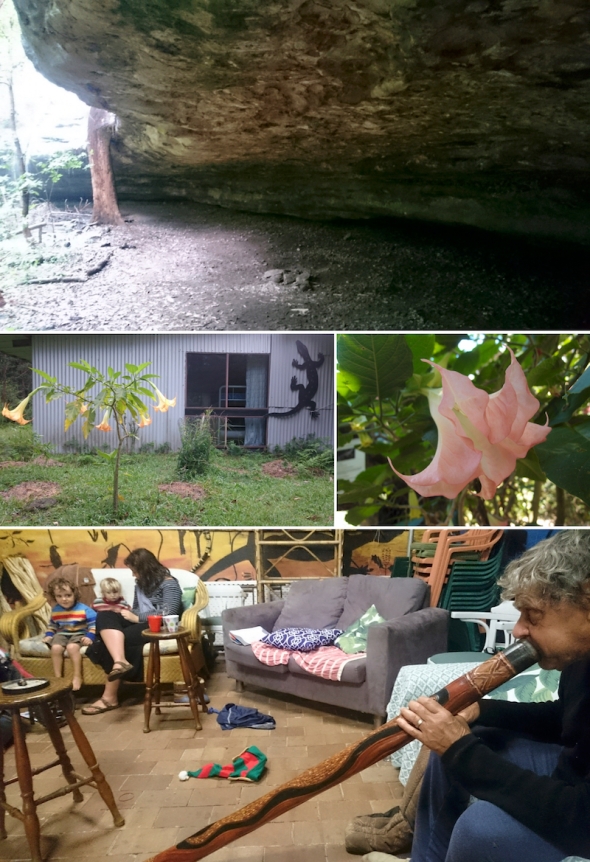 Nura Gunya, Ulladulla, NSW © p ward 2018
Nura Gunya, Ulladulla, NSW © p ward 2018
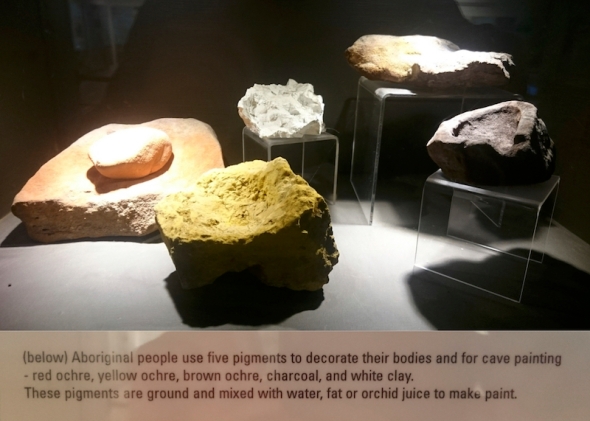 Aboriginal earth pigments, Jervis Bay Maritime Museum, NSW © p ward 2018
Aboriginal earth pigments, Jervis Bay Maritime Museum, NSW © p ward 2018
With many thanks to Martin for making the journey possible and to Francesca, Noah and Agnes, Sally and Miles, Noel and Trish and Alex for making it such a rich and beautiful experience.
© P Ward 2018
real time Sisters
Posted: October 31, 2017 Filed under: eARTh, the ash tree, Uncategorized | Tags: Arte Povera, arts research, Coldharbour Mill, ecopsychology, indigenous culture, poetry, Technology, Visual arts, West Somerset Leave a comment(Samhain) 311017
.
today time returns
and darkness drags us home, amidst swirling russet leaves,
to its familiar solstice resting place
as another year quietly slips away.
.
shadows lengthen
losing their resemblance to matter
and we descend into that underworld
of ancestors and past deities,
.
to industry and wonder,
to miraculous machines
and steam and noise –
hell for some, power for others –
.
weaving what was once made by hand
beneath clear open skies lit by a million stars,
connecting us to all that has been
and will ever be.
and the Sisters still sit
sharing their charms,
weaving mystery and fate
beyond our control or simple understanding.
 tall chimney, Coldharbour Woollen Mill, Uffculme, Devon © p ward 2017
tall chimney, Coldharbour Woollen Mill, Uffculme, Devon © p ward 2017
 engine houses, bobbins and spinning machines , Coldharbour Woollen Mill, Uffculme, Devon © p ward 2017
engine houses, bobbins and spinning machines , Coldharbour Woollen Mill, Uffculme, Devon © p ward 2017
 skein maker, Coldharbour Woollen Mill, Uffculme, Devon © p ward 2017
skein maker, Coldharbour Woollen Mill, Uffculme, Devon © p ward 2017
 threading the loom, Coldharbour Woollen Mill, Uffculme, Devon © p ward 2017
threading the loom, Coldharbour Woollen Mill, Uffculme, Devon © p ward 2017
 water wheel, Coldharbour Woollen Mill, Uffculme, Devon © p ward 2017
water wheel, Coldharbour Woollen Mill, Uffculme, Devon © p ward 2017
Last weekend I visited Dunster, a charming Medieval village in West Somerset with my family. We ‘watched’ stars inside an inflatable dome as part of Exmoor National Park’s Dark Skies program celebrating the unpolluted ‘darkness’ of the area and stayed at my brother’s cottage amongst the massive oaks and rich red soils of the Brendon Hills. On our way home we stopped off at Coldharbour Mill Museum in Uffculme, Devon, for one of their regular ‘Steam Up Days’. This restored working woollen mill is powered by water and steam engines (and electricity) and gives a fascinating insight into the ingenuity and industry involved in the production of wool and woven cloth over the last few centuries when Devon and Exmoor were one of the main centres for the wool trade in Britain. And all this on the days the clocks are turned back to solar time again and the Celtic New year begins – quite a brew for the imagination…
 dunster, west somerset © p ward 2017
dunster, west somerset © p ward 2017
 nettlecombe, west somerset © p ward 2017
nettlecombe, west somerset © p ward 2017
© P Ward 2017
painting in croatia, june 2017
Posted: August 2, 2017 Filed under: A BUNDLE OF STICKS, activ8, eARTh, the ash tree, Uncategorized | Tags: Arte Povera, Arts, arts research, Croatia, Dugi Otok, earth pigments, ecopsychology, Environmental art, indigenous culture, painting, Pigment, Visual arts 1 CommentOn a recent visit to the ‘long island’ of Dugi Otok on the Adriatic coast of Croatia I was taken by the unfamiliar marks of paint daubed on walls and buildings. Not graffiti as such or even nonsensical paintbrush cleansing ablutions but intentional spots and splashes of household paint. We thought they were maybe way markers or boundary signs. Whatever their purpose I enjoyed how they honed my vision both to the unfamiliar in such a rich but alien culture and also to another sense of painting in and of the environment. rocks and soil I + II, framed; dugi otok, croatia © p ward 2017
rocks and soil I + II, framed; dugi otok, croatia © p ward 2017
 dockside paintings; sali, croatia © p ward 2017
dockside paintings; sali, croatia © p ward 2017
Wherever we travel it is the unfamiliar colours, patterns, shapes, sounds, smells, tastes and materials that inspire and refresh our imaginations and remind us of the richness, diversity and potential of this planet that we share while also refreshing the ‘familiar’ in our own backyards. It only leaves us, as creative people, to show our gratuitude through sharing our vision and inspiration with others, hopefully continuing the cycle.
 paint daubs; sali, croatia © p ward 2017
paint daubs; sali, croatia © p ward 2017
 le citron de provence (Gonepteryx cleopatra) butterfly wings; dugi otok, croatia © p ward 2017
le citron de provence (Gonepteryx cleopatra) butterfly wings; dugi otok, croatia © p ward 2017
 ant highway, roadkill toad, pink flowers, white admiral; sali, dugi otok, croatia © p ward 2017
ant highway, roadkill toad, pink flowers, white admiral; sali, dugi otok, croatia © p ward 2017
 festival procession flowers; sali, croatia © p ward 2017
festival procession flowers; sali, croatia © p ward 2017
 a boat and three doorways; sali, dugi otok, croatia @ p ward 2017
a boat and three doorways; sali, dugi otok, croatia @ p ward 2017
 confectionery constellation, casual installation, pink house; sali, croatia © p ward 2017
confectionery constellation, casual installation, pink house; sali, croatia © p ward 2017
 handprints and paint; sali, croatia © p ward 2017
handprints and paint; sali, croatia © p ward 2017
 urban sights I, II + III; sali, croatia © p ward 2017
urban sights I, II + III; sali, croatia © p ward 2017
 pigment and paint I + II; sali, croatia © p ward 2017
pigment and paint I + II; sali, croatia © p ward 2017
 playground moths; sali, croatia © p ward 2017
playground moths; sali, croatia © p ward 2017
 four colours; dugi otok, croatia © p ward 2017
four colours; dugi otok, croatia © p ward 2017
 sticks and stones; dugi otok, croatia © p ward 2017
sticks and stones; dugi otok, croatia © p ward 2017
 unfamiliar shrub; sali, croatia © p ward 2017
unfamiliar shrub; sali, croatia © p ward 2017
 red and yellow makes orange, walls; sali, croatia © p ward 2017
red and yellow makes orange, walls; sali, croatia © p ward 2017
 nature park telašćica, dugi otok, croatia © p ward 2017
nature park telašćica, dugi otok, croatia © p ward 2017
 flying; dugi otok, croatia © p ward 2017
flying; dugi otok, croatia © p ward 2017
With thanks to the people, animals, plants and places of Croatia for a most inspiring experience and to Francesca, Noah and Agnes for sharing it with me.
© P Ward 2017
home: research, research and inspiration – early 2016 update
Posted: June 15, 2016 Filed under: A BUNDLE OF STICKS, activ8, BIOSPHERic, eARTh, Uncategorized | Tags: art and science, Arte Povera, arts research, collaboration, Devon, Earth, earth pigments, East Devon, eco art, Ecology, ecopsychology, Environmental art, Feeling, indigenous culture, Interdisciplinarity, North Devon, North Devon Coast, Pigment, poetry, Soil Culture 2 Commentswater, air and earth
sticks and stones
and, somewhere, fire
.
as the year unfolds
to a new life
within us
.
and you grow
and hold us rapt
in your emphatic personality
.
we deliberate upon Nature
each delicate
and deafening response
.
there is red and black and grey and green
dirt to some
riches to others
.
grinding away
what is left
to leave
.
more
and more
and more
.
we play
and learn
we play together
.
knees
teeth
home
.
 home: County Clare, Ireland © p ward 2016
home: County Clare, Ireland © p ward 2016
The year began with family and friends in a rainswept County Clare, Ireland, my home for 10 years. Many of the places I wanted to revisit and share were beneath meters of water. Things, of course, had changed for better and worse but the spirit of the land still shone through.
 home: Lake Vyrnwy, Powys, Wales © p ward 2106
home: Lake Vyrnwy, Powys, Wales © p ward 2106
Then more mountains and lakes, family and friends, as my brother’s path shifts to the Welsh borders, an area I have not visited before but will visit again. This time snow, ice, fog and sunshine accompanied my journey. Lake Vyrnwy reservoir submerged a Welsh village to supply England with water.
 home: Ilfracombe, winter 2016 © p ward 2016
home: Ilfracombe, winter 2016 © p ward 2016
And at ‘home’ the winter lashes the coastline, reshaping and reforming. Ilfracombe was originally named after King Alfred and was gifted to two of his sons as a sheltered harbour on the western approaches to his kingdom. Before then an iron-age hill fort overlooked the natural harbour from, what is now, Hillsborough nature reserve. This part of the North Devon coast is formed predominantly from Devonian slates, sandstones and shales and boasts some of the highest sea cliffs in England. We have a new studio here that we hope will provide a base for our creative endeavours and space for others to enjoy.
 home: Barnstaple Bay and Hele, North Devon © p ward 2016
home: Barnstaple Bay and Hele, North Devon © p ward 2016
 home: Holdstone Down, Combe Martin, North Devon © p ward 2016
home: Holdstone Down, Combe Martin, North Devon © p ward 2016
 let’s talk dirt! (White Moose Gallery, CCANW, Heritage Lottery Fund, Bideford Pottery, IGI Ltd, Roger Cockram)
let’s talk dirt! (White Moose Gallery, CCANW, Heritage Lottery Fund, Bideford Pottery, IGI Ltd, Roger Cockram)
In May, as part of the CCANW Soil Culture project, I led a walk and talk with the White Moose Gallery and supported by the Heritage Lottery Fund, to celebrate North Devon’s relationship with its earth resources. “Let’s Walk and Talk Dirt!” involved local potters, Harry Juniper and Roger Cockram, geologists Chris Cornford and Andrew Green, and soil scientist David Hogan to present some different perspectives about our local resources. Participants really enjoyed the interdisciplinary nature of the events but were frustrated by the lack of time to explore the subject matter in more depth. We are now working towards a ‘summer school’ to further explore North Devon’s potteries, pigments, rocks and soils.
 Sidmouth, East Devon © p ward 2106
Sidmouth, East Devon © p ward 2106
 Jacob’s Ladder beach, Sidmouth, East Devon © p ward 2016
Jacob’s Ladder beach, Sidmouth, East Devon © p ward 2016
The Thelma Hulbert Gallery, Honiton, East Devon invited me in May, to run painting with earth workshops to accompany their ongoing Soil Culture exhibitions. The first workshop introduced the ideas to a small group of partially sighted children from the WESC Foundation, providing a space for us to enjoy the more than visual experience of the process and materials. I was also excited to be exploring a new area of the country, encouraging me to find new pigments and learn about their geology and history. The second workshop, for artists, included an invigorating morning field trip to Jacob’s Ladder beach in Sidmouth to gather small quantities of the iron-rich red and green mudstones, and whatever else took our fancy, followed by an afternoon of furious experimentation grinding and binding a selection of pigments with a variety of mediums. It was great to meet some new faces in such a lively and friendly gallery.
 home: Wessex – Branscombe beach, East Devon; Hardy country (chalk and flint) © p ward 2016
home: Wessex – Branscombe beach, East Devon; Hardy country (chalk and flint) © p ward 2016
Something that did surprise me was the presence of chalk in the landscape of East Devon. Having been raised in Portsmouth I am familiar with the chalk and flint of the South Downs and Isle of Wight but wasn’t aware of it so far west along the coast. The sedimentary Cretaceous beds at Beer, that I saw from Branscombe beach during a day of research, lie above Upper Greensand that then rests on the more familiar Mercian Triassic red mudstones of South Devon. Apparently there is an ‘unconformity’ here in that the interceding Jurassic layer is missing, the area being land during that era. The nodules of flint and chert present in the Chalk and Upper Greensand that make up the beaches are also apparent in the local architecture creating further similarities to the South Downs and other Chalk areas across Europe.
One such region, that I also feel an affinity with through my ancestry and boyhood cycling adventures, is the Wessex Downs. The ancient country of Wessex encompassed Hampshire, west to the Cornish borders, and Wiltshire, Dorset, Devon and Somerset. In more recent times its character and characters have formed the backdrop for the literary works of Thomas Hardy. I was recently contacted by a research fellow from Exeter University to collaborate in a project to explore the value to health and well being of arts-based environmental workshops. His previous research looked at the work of Thomas Hardy in relation to the Wessex landscape. We are now waiting to see if our initial funding application has been successful before embarking on a major AHRC project around a similar theme. It has been fascinating working with a complete stranger towards a shared goal.
 Hele community group sculpture proposal sketches © eARTh 2016
Hele community group sculpture proposal sketches © eARTh 2016
Meanwhile, closer to home again we have been working with the local community towards re-landscaping an unsightly patch of ground behind the bus shelter in our village. It was good to be invited, to meet some more of our neighbours, to learn about the history of the village and to think how to we might alter such a space to celebrate the area. It was recently discovered that the area is owned (rather than it being public space) which has put the project back somewhat!?
 sketches in wood and stone © p ward 2016
sketches in wood and stone © p ward 2016
And back in the studio I have been enjoying putting together some new work (see previous post) using old offcuts of wood, old pots of paint and some new pigments. After 9 months I finally feel like I am settling in, enjoying the space and making something new, as well as finding time for my other interests and beautiful family. With a new arrival imminent we’ll be working hard to keep it up…
 jacob’s ladder, earth pigments on canvas © p ward 2016
jacob’s ladder, earth pigments on canvas © p ward 2016
 corn mill close, masonry paint on painted board © p ward 2016
corn mill close, masonry paint on painted board © p ward 2016
 offcuts – sketch in wood © p ward 2016
offcuts – sketch in wood © p ward 2016
© P Ward 2016
eARTh has MOVED…
Posted: October 30, 2015 Filed under: A BUNDLE OF STICKS, activ8, BIOSPHERic, eARTh | Tags: art and science, Arte Povera, arts research, Bideford Black, collaboration, Devon, Earth, earth pigments, eco art, Ecology, ecopsychology, Environmental art, indigenous culture, Interdisciplinarity, North Devon, North Devon Coast, Pigment, Visual arts 1 CommentMIDWINTER OPEN STUDIO
Saturday 28th and Sunday 29th November, 1100-1600
After an exciting first year, including a great exhibition at the White Moose Gallery, a number of successful workshops and OPEN STUDIOS and participation in other international projects, eARTh has relocated to a smaller, more rural space at Hele Corn Mill where we (myself and partner Francesca Owen) will be continuing our work with local earth pigments and plant dyes.
 hele corn mill and eARTh studio © f owen 2015
hele corn mill and eARTh studio © f owen 2015
Hele Corn Mill dates from 1525 and is a unique working watermill in North Devon. Located just 300m from stunning Hele Bay beach just east of Ilfracombe, a visit to the mill makes a perfect family visit. Opposite the mill is the Miller’s Wife Tearoom, where you can relax and enjoy a traditional cream tea or a slice of one of many delicious cakes, which are homemade every day. For directions, parking and opening times please visit www.helecornmill.com.
You are warmly invited to a pre-Christmas opening – a chat, some nibbles, a glass of wine and some art. If you cannot make the opening please feel free to visit anytime. eARTh will be open on a regular basis along with workshops, exhibitions and events throughout the year and is looking forward to seeing you soon.
For more information please visit www.earthnorthdevon.wix.com/arts
© P Ward 2015

